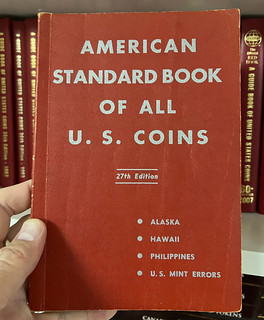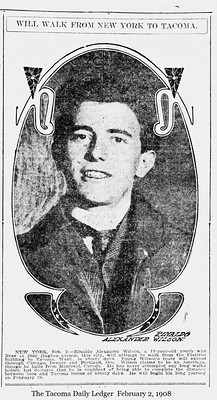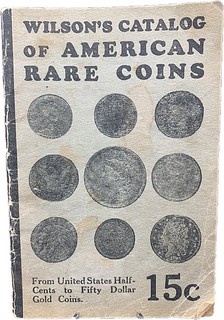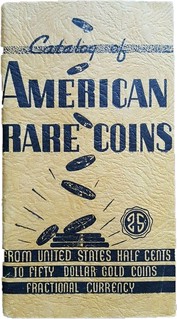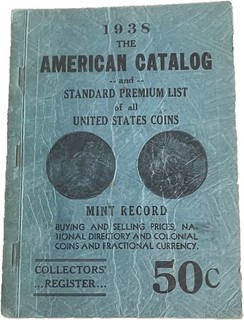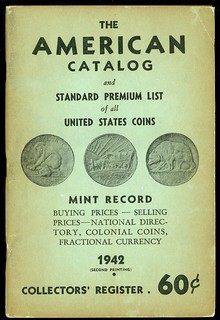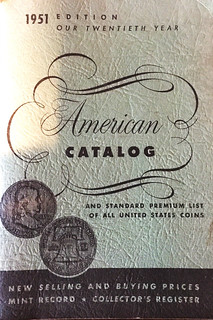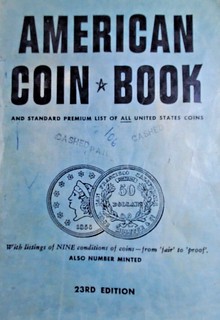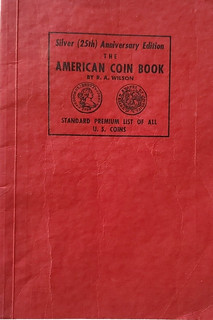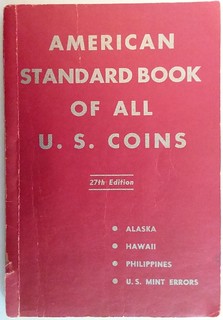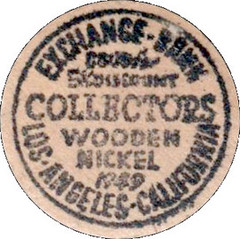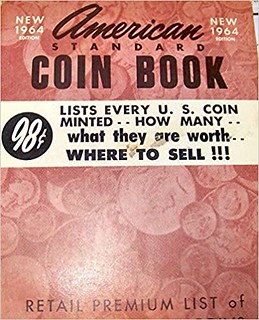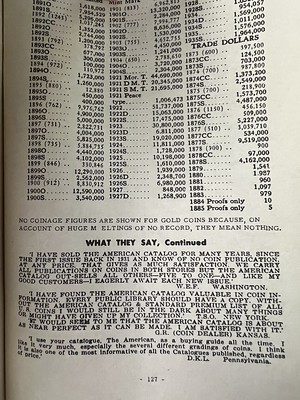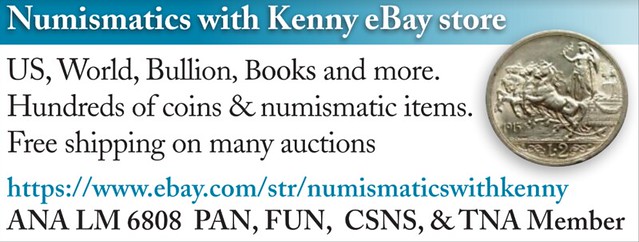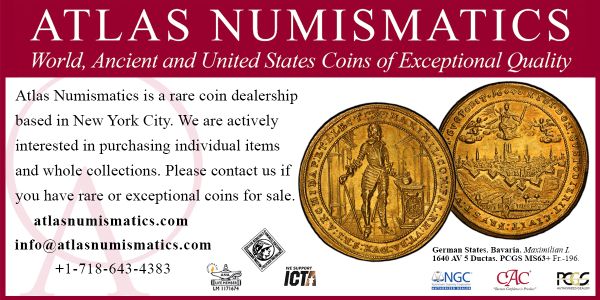
PREV ARTICLE
NEXT ARTICLE
FULL ISSUE
PREV FULL ISSUE
WHO WAS R. A. WILSON?
Who was R. A. Wilson?
I received an email from Dennis Tucker on Tuesday, May 2, asking about R. A. Wilson. Tucker inquired about a book with a red cover that has similarities to other books with red covers. Tucker wrote:
This is a collection of items I found. If I had known where this was going when I started, I might have saved it for a feature article in The Asylum.
Wilson became interested in coins in 1907 while employed at The Sovereign Bank of Canada. Rinaldo Wilson was a distance runner and a pedestrian, the popular term for people who walk long distances. In 1908 it was announced that Wilson planned to walk from the Flatiron building in New York to Takoma, Washington, a distance of 3400 miles in 90 days, beginning on February 20. Newspapers reported on his departure but none reported completion. In 1909 he participated in the Tacoma marathon as one of eight runners. When the third place winner finished, the remaining runners, including Wilson, withdrew from the race. In January 1910, Wilson planned to walk from Tacoma to New York, leaving on January 31. Apparently, he was unable to secure financial backing and abandoned the trip. Later, in June 1910, he announced that he would run from Butte to New York, a distance of 2500 miles, in 60 days. He planned to run at night. Again, there were no reports of completions. In 1913, it was announced that Wilson would join Peter Terway and Victor Morman in a race through every principal town in the United States. This was expected to take two years. Terway and Morman appeared at other events during that period suggesting that the distance event never happened. It appears that Wilson was much better at promoting events than he was in getting sponsors and completing the events. He was married to Ellie Berthanna Sathen (1891-1977) on March 4, 1916. They had four children. His marriage license gave his profession as salesman. He served as a private in the Marines during the First World War. He was stationed at Quantico, Virginia, and posted overseas in France. In the 1920 census, his profession was listed as toy manufacturing. In 1920 it was announced that Wilson would attempt to run from Seattle to New York, beginning on May 10. On his run he would wear his Marine uniform and promote the Corps. Again. no follow-up reports. I doubt if he completed any of the events mentioned. The 1922 birth record for his daughter lists his address at 8129 S. Figueroa and occupation at Powerplus Oil. In the 1930 Census, his profession was listed as candy salesman. In a 1962 recollection, Wilson mentioned that he was annoyed with advertising for the 1913 Nickel and felt that a book was needed that had accurate information. He soon began publishing a series of coin books with various similar titles. In 1930, the American Catalog was published. His publishing company was American Numismatic Company, located at Box 11655, Wagner Station, Los Angeles 17, California. In 1932, American Coin Book was published by American Publishing Company at 3959 West Sixth Street, Los Angeles 3. California. Some editions show a longer title, American Coin Book and Standard Retail Premium List of All United States Coins. The twenty-fifth edition was published in 1957. In August 1934, The Numismatist announced the membership application of R. A. Wilson with address as P. O. Box H, Hyde Park, Los Angeles, California. His collecting interests were Half Cents and Civil War Tokens. In September he was confirmed as member 4546. In 1934 he released The Federal Catalog of all United States Coins. A 1935 ad in the May issue of The Numismatist had a picture of a book with the title The American Catalog and Standard Premium List of All United States Coins. Alongside was the written description of The American Coin Catalog of all United States Coins. Wilson was not mentioned in the ad. In 1936 he reported that he was teaching a class on coin collecting. In 1938, Wilson sponsored Joseph Oberwise for membership in the ANA. Oberwise ran ads in Wilson's American Catalog. Wilson. In turn, placed ads on the back of Oberwise coin boards. David Lange devoted page 178 of Coin Collecting Boards of the 1930s & 1940s to a discussion of Wilson.
Lange discussed the proliferation of premium books like those published by Wilson. The 1938 edition of American Catalog of All United States Coins had an illustration of the 1918-S 8 over 7 quarter before this was generally published elsewhere. Wilson kept up with changes. In the 1940 Census, his profession was listed as catalogue publisher. At the 1940 ANA convention, R. A, Wilson was recognized for sponsoring the most new members as a lay member, (not an officer) He was unable to attend, having suffered an automobile accident. In 1946, Roland C. Atwood issued National Check and Premium List of All U. S. Transportation Tokens. This was published by the American Numismatic Company of Los Angeles.
In 1951, R. A. Wilson, Sr. donated a copy of American Catalog to the A.N.A. It was described as
In 1957, The Numismatist described one of the books:
Wilson was an active member of the A.N.A. and in California organizations. He made presentations to clubs and conducted radio interviews. In his time he was consulted on questions of authenticity. In 1962, Rinaldo retired and passed the business on to a new generation. Publication was taken over by James S. Wilson and the American Publishing Company at 3959 West Sixth Street, Los Angles. James was the second son of Rinaldo. In 1962, Coin World stated,
Rinaldo Wilson died in Los Angeles on October 23, 1978. His obituary in the Los Angeles Times was very brief and mentioned three surviving children, 14 grandchildren and 9 great-grand- children. He is buried at Inglewood Park Cemetery. List of Wilson titles mentioned somewhere:
This article was compiled over a period of three days without access to any of the books. I suspect a longer study with the books would clarify sources and what material was included and repackaged across the various titles and editions. Given Pete's evidence, I concur that Wilson is under-appreciated by today's numismatists and numismatic bibliophiles. Can anyone add more to this story? I wonder if the "R.A. Wilson" styling was an attempt to sound less ethnic, although his full name was used in the non-numismatic newspaper articles Pete found. In college I worked with a young man whose first name was Rolando. He later legally changed it to Ryan, and at the time I could only wonder why - I thought "Rolando" was way cooler than "Ryan", and maybe today it would be. The Wilson publication has its "quirks", and while it may have preceded the Whitman publication, the latter out-improved its content, and that's a big reason why today when collectors refer to the Red Book, they mean A Guide Book of United States Coins from Whitman. Here are some of the idiosyncrasies Dennis notes in the 1960 American Standard Book of All U.S. Coins. A note on p127 states that their publication began in 1931. -Editor
"His coverage of Alaska, prominently advertised on the front cover, has no illustrations and just two lines of narrative: "The Philippines gets a full page of photos (but no pricing and very little numismatic information, some of it incorrect).
"Error coins are lavished with three pages of coverage, apparently underwritten by Michael Kolman Jr. and affording nearly a full page to illustrate the
"In the silver dollars section Wilson invokes a grand old name of numismatics that most hobbyists today have never heard:
"In the commemoratives section, Wilson's advice sounds like it was written by Betty Crocker:
"Mintages are separated in the back of the book, which was still the style of the Red Book at the time. (The modern Red Book format of including mintages within the coin listings would come in 1962.) For his mintages, Wilson gets lazy/hazy on the specifics, writing,
Wayne Homren, Editor The Numismatic Bibliomania Society is a non-profit organization promoting numismatic literature. See our web site at coinbooks.org. To submit items for publication in The E-Sylum, write to the Editor at this address: whomren@gmail.com To subscribe go to: https://my.binhost.com/lists/listinfo/esylum All Rights Reserved. NBS Home Page Contact the NBS webmaster 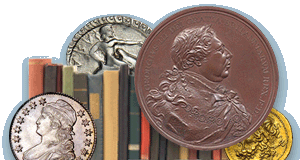
|
